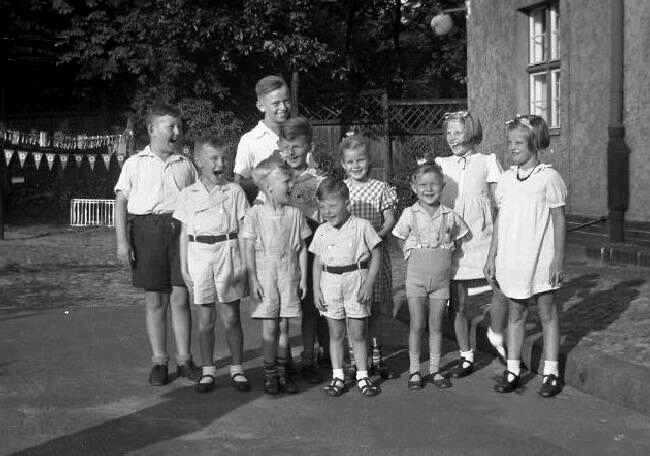
German Boys' Footwear: Chronology--The 1930s

Figure 1.-- We also see younger boys and girls wearing many styles of cloesed-toe sandals. We see both one- and two-strap styles. They seem to have been done in different colors, although this is difficult to make out in the black and white photography of the day. These German children wear many of the popular styles.
|
|
The sturdy high-top shoes for boys continued toi be worn in the 1930s, although mostly for pre-teen boys. We see far fewer older boys wearing them, especially by the end of the decade. Younger boys wore these high-top shoes into the 1950s. Most older boys and many younger boys wore low-cut oxfords. I think some German mothers considered them healthier for children as they offered more support. There may also have been class connotations as they appear to have been more of a working-class style. Hopefully our German readers will provide more information here. We do not see any German boys wearing sneakers in the 30s. We do see many children wearing sandals and strap hoes. They were commonly worn by younger boys although we see some older boys wearing thm as well. We do see a few boys wearing what look like canvas shoes designed liked strap shoes. We also see younger boys and girls wearing many styles of cloesed-toe sandals. We see both one- and two-strap styles. They seem to have been done in different colors, although this is difficult to make out in the black and white photography of the day. These German children wear many of the popular styles (figure 1).
We see German boys wearing a wide range of different footwear types in the 1930s. The sturdy high-top shoes for boys continued to be worn in the 1930s, although mostly by pre-teen boys. Low cut Oxfords were becoming more common. We thought that the choice of high-top shoes and Oxfords was primarily a family matter. But here we see boys in the same family wearing both types of shoes (figure 1). We do not see any German boys wearing sneakers in the 30s. We do see many children, both boys and girls, wearing both sandals and strap shoes. There were many types and styles of these shoes worn. We see some boys wearing what look like canvas shoes designed liked strap shoes. This appears to have been a casul shoe type. We are not sure about construction details or what they were called. We also see younger boys and girls wearing many styles of closed-toe sandals and strap shoes. There appear to have been both dress and play styles. We see both one and two-bar styles. We also see boots being worn, but they were not very common. We rarely see German children going barefoot in the 1930s. The German children in the photograph here wear many of the popular styles (figure 1).
We see far fewer older boys wearing the high-top shoes, especially by the end of the decade. Younger boys wore these high-top shoes into the 1950s. The high top shoes seem most common for pre-teen boys, mostly boys uo to about 8-9 years of age, especially by the end of the decade. Most older boys and many younger boys wore low-cut oxfords. I think some German mothers considered hightops healthier for younger children as they offered more support. We at first thought strap shoes were most common for younger boys, but we think it may have been the hightops. There may have been differebnces from family. We see some older boys wearing hightop shoes, but on ballanvce they seem nore common with the younger boys. One aspect that we are not sure about is that some children may have had both hightop and strap shoes and may have decided on their own what to wear. Here we are just not sure. We do see many children wearing sandals and strap shoes. The strap shoes may have been more comfortable to wear, but sometimes boys do not like to wear garments and shoes that girls wear. Here there was a wide age range. Of course many older girls wore strap shoes. We see older boys wearing strap shoes and sandals than high top shoes, although this is just our initial assessment. There were many types and styles of these strap shoes/sanadals worn. Low cut lace shoes were most common wuith older boys, but we so see some younger boys watring them.
Social Class
There may also have been class connotations associated with footwear. The high-top shoes appear to have been more of a working-class style. We are less sure about strap shoes and sandals. Hopefully our German readers will provide more information here.
Gender
We see German boys and girls wearing some of the same footwear styles in the 1930s. Older boys mostly wire kace lowcuts. Girls also wore lowcut lace shoes, but strap shoes and sandaks seem miore common.
Colors
Boys wore mostly black or brown shoes. Wjite shoes were much less common. We are less sure about the strap shoes and sandals. They seem to have been done in different colors, although this is difficult to make out in the black and white photography of the day.
HBC

Navigate the Boys' Historical Clothing German pages:
[Return to the Main German 20th century footwear chronology page]
[Return to the Main German footwear chronology page]
[Return to the Main German footwear page]
[German art]
[German catalogs]
[German choirs]
[German movies]
[German royalty]
[German school uniforms]
[German youth groups]
[German sailor suits]
[Lederhosen]
[Ethnic]
[Tights]
[Long stockings]
Navigate the Boys' Historical Clothing Web Site:
[Introduction]
[Activities]
[Biographies]
[Chronology]
[Clothing styles]
[Countries]
[Bibliographies]
[Contributions]
[FAQs]
[Glossary]
[Images]
[Links]
[Registration]
[Tools]
[Boys' Clothing Home]
Created: 1:14 AM 7/17/2007
Last updated: 2:33 AM 11/4/2013



